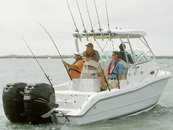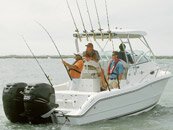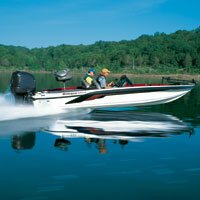Tips for Using a Fishing Gaff
- Make sure the gaff hook is facing downward and toward the boat as the fish is brought alongside.
- Don’t gaff a fish toward the tail. Rather, bury the gaff in the forward shoulder of the fish. Always aim for the top of the fish toward the head for more control and to protect the meat.
- Once a fish is on the gaff, instruct the angler to back off on the drag or disengage the reel with the clicker on.
- Don’t attempt to gaff a fish that is too deep and beyond reach. Be patient and wait for a clean shot.
- While waiting for the gaff, the angler should never lift the fish’s head out of the water.
- Purchase a high quality gaff. This is no place to compromise. The hook should be forged steel and the handle crafted from weather-resistant aluminum or a composite material with foam or rubber grips.
- If at all possible, carry a few gaffs in different lengths and sizes.
- The designated gaff man should maneuver the gaff into position behind the fishing line to avoid wrapping the line around the gaff.
- When gaffing any fish, always sweep the gaff in toward the boat.
- Once the gaff hook has found its home, carefully lift the fish up and in the boat, and into the cooler or fishbox in one smooth motion.
Do you have what it takes to be an expert gaffer?
Proper gaffing techniques lead to more fish in the box. Yet, you’d be surprised at the number of quality fish lost due to poor gaffing technique. While they won’t readily admit it, even the most seasoned deckhands experience the occasional gaffing mishap.
To achieve the greatest level of fish-boating success, your first priority should be to clear the deck of any unnecessary obstructions. Wash-down hoses, 5-gallon buckets, loose trolling lures, extra rods, all should be safely secured. The last thing you want is the angler or designated gaff man tripping during the last crucial moments of a heated battle.
Next, talk to each other. A clear line of communication is a key to success in the cockpit. The angler should announce when he or she sees the fish by shouting "color." Then, the angler must do their best to control the fish as it approaches the boat. Let’s not forget that the majority of angler or tackle failure incidents occur during the first and last 30-seconds of any fight, which is exactly when most fish are lost. The angler fighting the fish must stay on his or her toes – ready for quick maneuvers to prevent the prized quarry from swimming under the boat. If the fish is determined to set itself free, the angler must submerge the rod tip as far as possible so the circling fish will safely clear the running gear. Once the angler has regained control, the piscatorial prize should be guided into position and presented to the designated gaff man. Remember that boating quality fish has always been a team effort!
The right tool for the job
If you follow the Southern Kingfish Association, you’ve likely seen seriously long gaffs. The extra length allows competitors to reach out and snatch “green” fish that might still have another run left and thus, another chance to escape. With prestige, major sponsor support and thousands of dollars on the line, it’s no wonder the top teams have tailored the tool to meet their specific needs. But try sticking a 12-foot long gaff in an angry 65-pound cobia, and you’ll likely end up with soar arms, a bruised ego and not much else.
Admit it; we have all witnessed quality fish lost at boat-side because of gaffing errors, most of which can be blamed on utilizing the wrong tool for the job. The trick is to match the gaff to the size and species of fish you expect to encounter. Hefty grouper or mutton snapper which generally pop up right next to the boat, are easier to snatch and carry their weight much differently than a smoker king or wicked wahoo – both notorious for escaping death with last second scorching-runs.
Your vessel must also be considered. Large boats with high gunwales require long gaffs which provide the opportunity to reach trophy pelagics that always seem to take off once they see the boat. Your gaff must be long enough so that you shouldn’t need to stretch most of your body over the side which will leave you unbalanced. The gaff man needs to focus on accuracy, leverage and lifting, not keeping themselves aboard. While smaller center-consoles boats with low gunwales call for shorter gaffs, it’s the body posture that leaves you the most comfortable that is a major factor when selecting the ideal gaff length.
The throat, which is the gap between the shank and point-of the gaff hook, needs to be wide enough to impale the gaff point into a thick-enough part of the fish so that it won’t tear free when the fish thrashes wildly – and it will! Select a gaff hook with a throat that, when placed across the back of the fish, positions the point to embed in the thick shoulder meat just behind the head. This is where the gaff is strongest.
Another measurement to consider is the diameter of the steel used to form the gaff hook. If the steel is too thin, it may straighten or pull free of the flesh on a big fish - both situations may result in lost fish. If the diameter of the hook is too thick, it can be hard to set and will likely damage a large portion of meat. For large cobia, medium tuna and gaffer dolphin, a four- or five-inch gap with a 3⁄8-inch or even 1⁄2-inch diameter hook is ideal. For snake kings, schoolie dolphin and football tuna less than 20 pounds, a three-inch throat and 1⁄4-inch diameter hook will work fine.
Finally, when the fish is next to the boat, keep your composure and wait for a clean shot. Victory is only inches away!
-Captain Mike Genoun
Shared with Permission by FloridaSportFishing.



